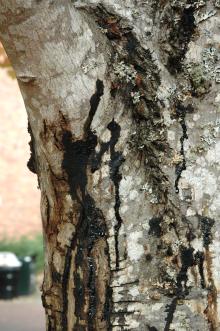See:
Maple (Acer spp.) - Phytophthora Root Rot
Cause The fungus-like organism, Phytophthora cactorum was found by the OSU Plant Clinic associated with bleeding trunk cankers. The disease and organism have also been reported from maples in home gardens in southwest Idaho. Other hosts of this organism that display bleeding cankers include beech, birch, chestnut, elm, horse chestnut, linden, oak, sweet gum, walnut, and willow. These organisms are favored by wet conditions and warm conditions. Cankers have been associated with sprinkler irrigation that wets tree trunks.
Symptoms Bleeding cankers 4 to 14 inch in diameter generally occur on the main trunk but can also occur on scaffold branches. The dead underlying vascular cambial tissue may be stained reddish-brown. These dark brown-to-black areas on the bark often look wet with a slow oozing of liquid from the lower portion of the canker. Tree canopies display foliar chlorosis, branch dieback, and premature autumn senescence. Trees may go on to die or survive several years.
Cultural control
- Do not let sprinkler irrigation wet landscape tree trunks.
- Avoid ponding of water around trees.
- Avoid over- or underwatering plants.
- Plant in well drained areas.
- Prevent mechanical injury to trees.
Chemical control To minimize the development of resistant fungi, alternate or tank-mix fungicides from different groups that have different modes of action. Use fungicides as preventative treatments; they generally do not save heavily infected plants. The phenylamide and phosphonate fungicides (Group 4 and P7 fungicides) do not kill these organisms. They can only prevent establishment of the organism before it gets into the plant. They can also prevent continued growth if the organism is already inside the plant thereby delaying symptoms that might have developed. Once chemical activity has subsided with time, the organism can resume growth within infected plants.
- Aliette at 5 lb/100 gal water. Do not use with adjuvants. Group P7 fungicide. 24-hr reentry.
- ArborFos is registered for tree injections. The number of capsules used is based on tree size. Group P7 fungicide.
- Fosphite at 3 quarts/100 gal water. Do not use copper products within 20 days of treatment. Group P7 fungicide. 4-hr reentry.
- Phospho-Jet is registered for tree injections. Rates are based on tree size. Group P7 fungicide. 4-hr reentry.
- Rampart at 1 to 3 quarts/100 gal water/A. Do not use copper products within 20 days of treatment. Can also be trunk injected. Group P7 fungicide. 4-hr reentry.
- Segovis at 0.65 to 3.2 fl oz/100 gal water as a soil application. Group 49 fungicide. 4-hr reentry.
- Subdue MAXX at 1 to 2 fl oz/100 gal water as a drench. Apply 1 pint of solution per 1 sq ft. Group 4 fungicide. No restrictions on reentry when used as a soil drench.
References Brown, L., Harrington, M., Murdock, M.R., Woodhall, J.W., Bell, S. and Spinazola, J. 2021. Phytophthora cactorum Causing Bleeding Canker of Acer x freemanii in Southern Idaho. Plant Disease. 105:4172-4173.


